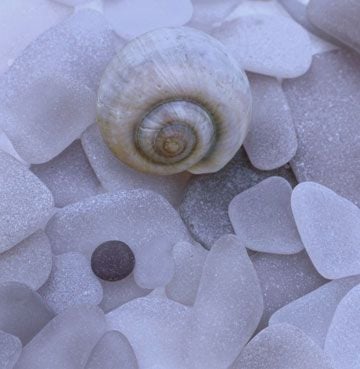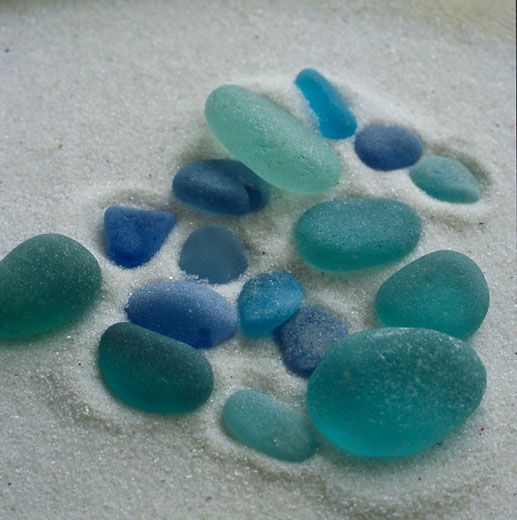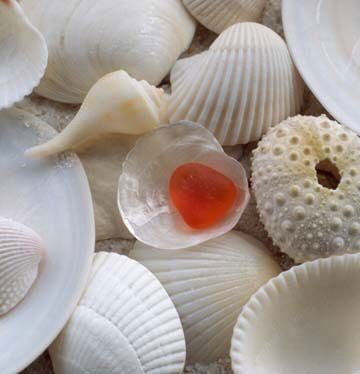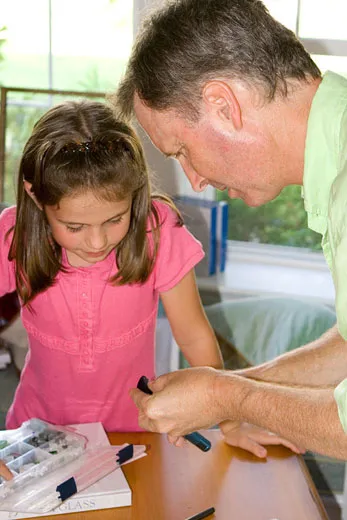Sea Glass: The Search on the Shore
Part of the sea glass hunting elite, Nancy and Richard LaMotte are finding the treasures they covet harder to come by
/https://tf-cmsv2-smithsonianmag-media.s3.amazonaws.com/filer/seaglass_631.jpg)
Nancy LaMotte's eyes are a clear blue-green, the color of antique Coca-Cola bottles, but brighter. She scans the sand at her feet: gritty knots of seaweed, smashed oyster shells, driftwood – wait! There, by that barnacled log! She bends to pluck a perfect turquoise lozenge of sea glass; while she's reaching for it, she also spots an arrowhead. "Oh, look," she coos. Though her smile is modest, the double whammy is a bit much for me, since the only treasure I've spotted so far on this Chesapeake Bay beach is a grimy scrap of plastic.
For what it's worth, LaMotte and her husband, Richard, are among America's sea glass hunting elite; she makes sea glass jewelry in their Chestertown, Md. home, he—vice president of an environmental analysis firm by day—is the author of a seminal sea glass book, and together they run Sea Glass Publishing, which prints a whole product line for beachcombers, from pocket journals to posters. Chances are that neither of them would stoop for a single one of the brown and white shards you found this summer and then forgot about in a fishy-smelling jar in your garage (The LaMottes keep their collection in the garage, too, but in a custom-made cabinet of color-sorted cafeteria trays). No, they hold out for purple, teal, black and—rarest of sea glass shades—orange.
Being a sea glass expert is a serious enterprise. The LaMottes can recite Depression-era tableware patterns, glass-making recipes, and the saltwater pH levels needed to give sea glass its frosted look. And they don't go hunting on any old swimming beach—collectors of their caliber kayak, snorkel, rappel down cliff faces and hike lava floes to reach premium beaches, which they pinpoint by consulting prevailing wind patterns and even the cycles of the moon, to hit the tides exactly right. They also study maritime history to determine which shipping routes and resorts were popular in the late-1800s, when much desirable glass was made. The private beach that Nancy and I searched for an hour, for instance, is south of a bayside amusement park where patrons likely dropped glass into the water from the 1870s to the 1960s.
Yet even with these resources—and remarkably keen eyesight—at their disposal, the LaMottes and their colleagues have noticed an unsettling trend in recent years: "Sea glass is getting harder to find," Richard told me earlier that day in his kitchen, fingering his favorite foggy jewels like a pirate deep in his plunder. Collectors across the country have noticed supplies dwindling along many of the traditionally bountiful coastlines: Northern California, parts of Hawaii, the southern shores of the Great Lakes and the East Coast north of Cape Hatteras. Increasingly, serious collectors are leaving this country to canvass glassier shores.
"People are traveling to Spain and England," says Mary Beth Beuke, president of the North American Sea Glass Association, a coalition of sea glass collectors and artisans. At the group's annual festival, to be held this year on Columbus Day weekend in Lewes, Del., Beuke will be delivering a lecture entitled "To the Ends of the Earth," describing the lengths modern enthusiasts must go to improve their collections. She is in the process of planning her own trip to Greece.
Running out of "mermaids' tears" seems impossible, and a little sad, like running out of seashells. But one man's collectible is another man's trash, in this case quite literally. Sea glass is essentially pretty litter, broken bottles and jars abandoned on the beach or heaved overboard years or decades or even centuries ago, then smoothed by the ocean's movements. The Caribbean is a great place to find shards from case gin and Dutch onion bottles, for instance – they're rubbish from old rumrunners. Several storied sea glass hunting grounds, like Glass Beach in Fort Bragg, Calif., are actually former town dumps.
But attitudes toward oceanfront property, and litter in general, have changed dramatically since the Glass Beach dump closed down in 1967. Americans' newfound reluctance to hurl junk into the sea has limited the supply of fresh glass, and with the advent of mass-market plastic, glass is a much less popular packaging material than it used to be. There have been sweeping efforts to clean up existing beach garbage, even the collectible kind, and restoration projects meant to save eroding coastlines frequently involve importing tons of sand that is typically glass-free. (Though occasionally, it must be said, this works in collectors' favor: A recent beach renewal in Lewes unearthed scads of valuable black bottle pieces from the Severn, a cargo ship wrecked in the 1770s. Guess what sea-glass festival attendees will be doing between lectures?)
Finally, some prime beaches are simply picked over. Extreme sea glass hunting is admittedly a niche hobby (the LaMottes tell of a woman who patrols a particularly fruitful stretch of sand 365 days a year) but pocketing a few choice pieces here and there is a standard summer pursuit for many Americans. Collectors guard their beach locations ever more jealously against the stiffening competition. As glass gets scarcer, prices rise—treasures like the Shard of the Year, chosen at the annual festival, can be worth hundreds of dollars—and with the growing sea glass jewelry trade there's also a market for faux sea glass, pieces that have been mechanically tumbled or chemically treated. These fakes are anathema to diehard beachcombers like Beuke and the LaMottes and other top-level collectors, who formed their association a few years ago in part to "educate" consumers about the virtues of the real thing.
The LaMottes, for their part, try not to let the controversy take the fun out of hunting. There are other types of seaside prizes for the taking–they are particularly proud of the fossilized bison teeth they found not far from where I went looking , not very successfully, with Nancy. Amateurs like me can take heart in the fact that this year's premier hunting days are still ahead of us (Nov. 13th and Dec. 12th, according to the Perigean spring tides) but it's probably true that "the best collectors will always find pieces," as Nancy likes to say. She and Richard have already searched Bermuda and Scotland and will continue to cast a wide net—there are beaches in Italy, and particularly in Venice, home of the Murano glass factories, that they can't wait to explore.
But they won't forsake their native shores. In their garage, alongside their favorites, the LaMottes have buckets full of sea glass pieces that are not quite smooth or rounded enough to be worthy of display, but which could be quite lovely after a few more years in the water.
They're thinking about going down to the beach and throwing them back.



